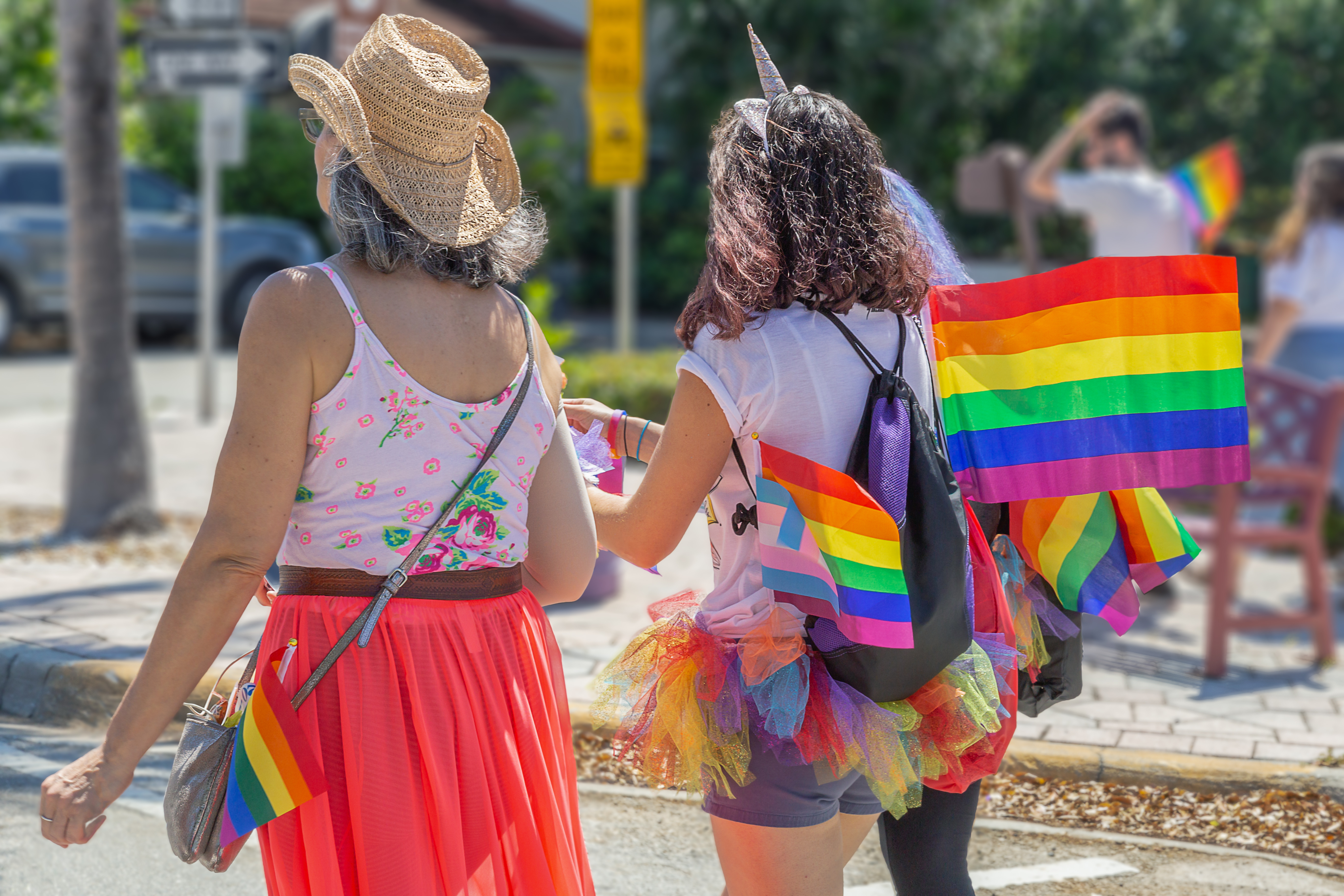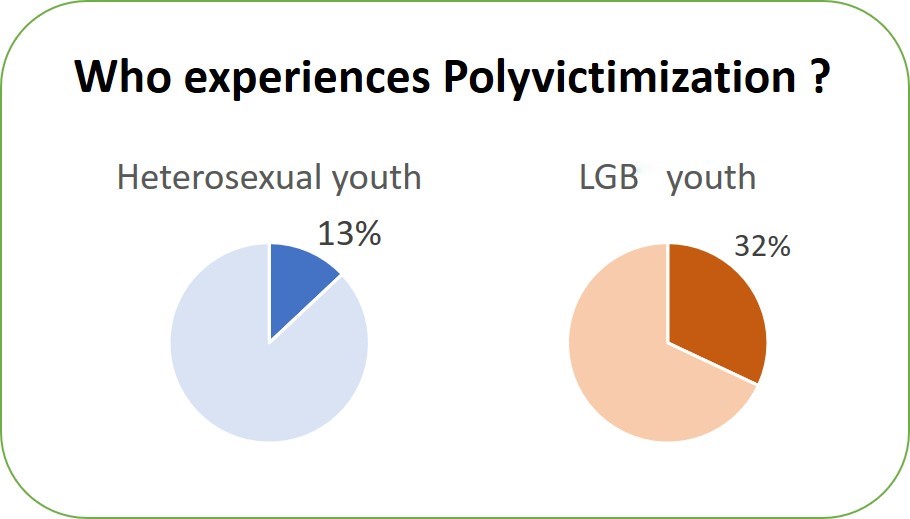Polyvictimization and Suicide Risk among Lesbian, Gay, and Bisexual Teens
Lesbian, gay, bisexual, transgender and queer/questioning (LGBTQ) teens continue to face bullying, discrimination, and violence in their schools and communities, in large part due to the continued stigma against sexual and gender minority identities. LGBTQ teens also continue to attempt suicide at rates far greater than heterosexual teens. Here, we summarize key findings and implications of our recent study on the relationship between victimization and suicide risk among LGB teens.
Minority stress is a framework that explains the connection between victimization and suicide risk among sexual minority communities. The framework describes how stigma against sexual minorities plays out externally through violence and discrimination and internally through negative attitudes and beliefs like internalized homophobia/biphobia/transphobia and expectations of rejection. In turn, these external and internal factors affect mental and physical health.
While the minority stress framework emphasizes how a climate of stigma affects sexual minorities, research with LGBTQ teens often focuses on how single types of victimization, such as bullying or interpersonal violence alone, might affect health. Thus, we are left with questions about LGBTQ teens who experience more than one type of violence and their risk for suicide.
By turning our attention to polyvictimization, or the experience of surviving multiple types of victimization, we may have a better assessment of how stigma broadly affects LGBTQ teens and a more accurate snapshot of what a climate of stigmatization looks like.
We took this approach in our recent study using data from the Youth Risk Behavior Surveillance System (YRBSS). Previously, we knew little about LGB teens’ polyvictimization nationally, or how polyvictimization might connect to their risk for suicide. We used nationally representative data from high school students in the United States in 2017 to explore this topic (N = 13,137), and defined polyvictimization as two or more experiences of victimization. Unfortunately, a question on transgender status is not yet available at the national level for YRBSS, and so transgender youth were not included in this analysis.
This study had three key findings:
Key Finding 1: 32% of LGB high school students experienced polyvictimization compared to only 13% of heterosexual high school students.

Key Finding 2: Both LGB identity and polyvictimization predicted more suicide risk behaviors (i.e., persistent sadness/hopelessness, seriously considering suicide, making a suicide plan, attempting suicide). Essentially, both .students who identified as lesbian, gay, or bisexual or students who experienced more types of victimization reported greater risk for suicide.
Key Finding 3: Among high school students who experienced polyvictimization (i.e., experiencing two or more types of victimization), LGB students were more likely to attempt suicide than heterosexual students. This finding emphasizes that victimization is not the only cause of the high rates of suicide we see among LGB students, and likely other factors, such as LGB youth’s lack of family support or negative beliefs about themselves, may be contributing to high suicide risk.
This study affirms that LGB high school students face victimization from multiple sources in their lives, and that LGB students continue to be at greater risk for suicide, even after accounting for their higher rates of polyvictimization. As the minority stress framework lays out, LGB suicide risk cannot be understood as a function of victimization alone, as it likely is also affected by internal stressors, such as feeling a need to hide one’s identity, or an absence of protective factors, such as family support or school connectedness.
As researchers and practitioners, how can we help?
This study points to a need for a renewed focus on primary prevention, or moving upstream to stop the root causes of victimization and suicide among LGBTQ teens. Downstream actions, like consequences for bullying or connecting teens at risk for suicide to resources, are useful for responding to and mitigating the risk of victimization and suicide among LGBTQ teens, but do not stop these experiences from occurring in the first place.
Primary prevention may look like improving climates and combating stigma against LGBTQ students in systems like schools or families. Primary approaches help reduce environmental risk factors and enhance protective factors for LGBTQ teens. Examples include investments in programs like gender sexuality alliances (GSAs) and specific anti-bullying/anti-harassment policies for LGBTQ students in schools or in programs like the Family Acceptance Project that facilitate family acceptance and support of a youth’s LGBTQ identity.
Support suicide prevention approaches that address LGBTQ teens.
As recommended by the Model School District Policy for Suicide Prevention developed by The Trevor Project, American Foundation for Suicide Prevention, American School Counselor Association, and National Association of School Psychologists, district suicide prevention plans may benefit from inclusion of specific content for high-risk youth, including those who are LGBTQ. Additionally, training on LGBTQ issues for providers who care for youth at risk for suicide is critical, as LGBTQ teens benefit from mental health care that affirms and supports LGBTQ identities.
Stigma and minority stress increase suicide risk among LGBTQ teens. This national study of high school students in the U.S. highlights how the multiple types of violence experienced by LGB youth increase this risk and provides continued support for the need to build safe and supportive environments for LGBTQ teens. Practitioners’ efforts to reduce suicide among LGBTQ teens would benefit from going beyond individual-level treatments and ensuring that they develop in a world in which they are protected, supported, and affirmed.
To read the original article, click here.
References
- Minority stress | https://psycnet.apa.org/record/2012-32754-018
- YRBSS | https://www.cdc.gov/healthyyouth/data/yrbs/index.htm
- LGB youth - lack of family support | https://pubmed.ncbi.nlm.nih.gov/21073595/
- LGB youth – negative self-belief | https://www.sciencedirect.com/science/article/abs/pii/S027273581000125X?via%3Dihub
- GSAs | https://gsanetwork.org/resources/building-your-gsa/
- Family Acceptance Project | https://familyproject.sfsu.edu/training
- Model School District Policy for suicide prevention | https://www.thetrevorproject.org/wp-content/uploads/2019/09/Model_School_Policy_Booklet.pdf
- Link to original article | https://onlinelibrary.wiley.com/doi/epdf/10.1111/jora.12595
Authors
 Michelle M Johns, PhD, MPH; Division of Adolescent and School Health, Centers for Disease Control and Prevention, Atlanta, GA
Michelle M Johns, PhD, MPH; Division of Adolescent and School Health, Centers for Disease Control and Prevention, Atlanta, GA
 Amy Green, PhD, Trevor Project, West Hollywood, CA
Amy Green, PhD, Trevor Project, West Hollywood, CA

